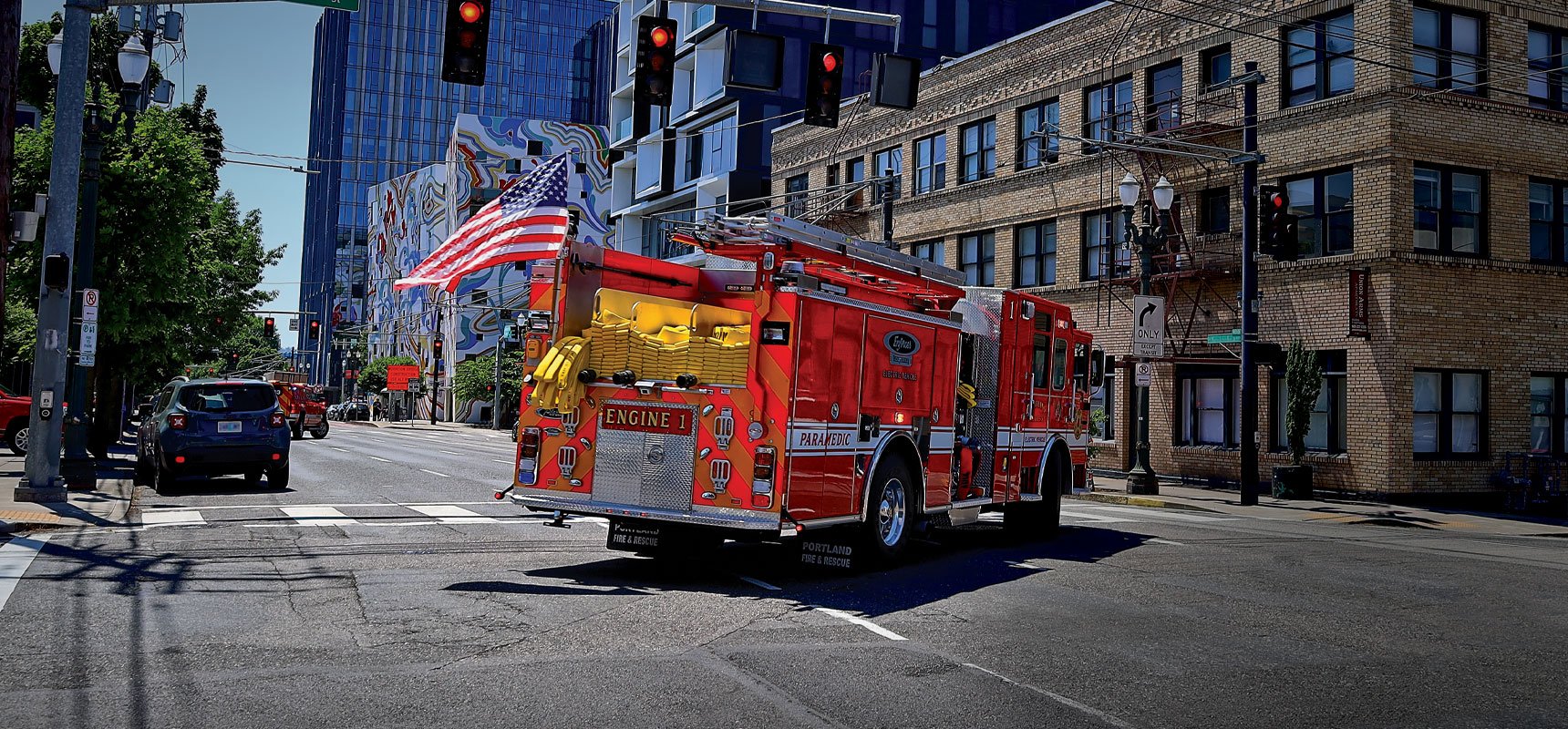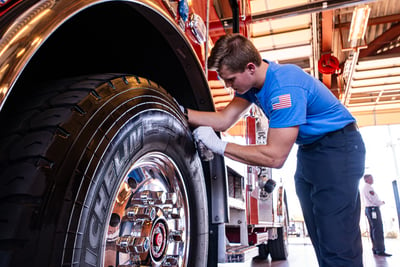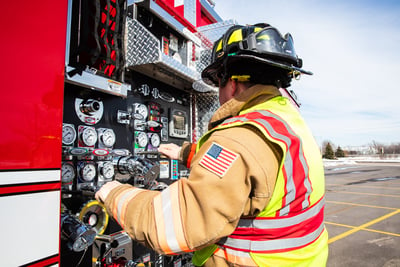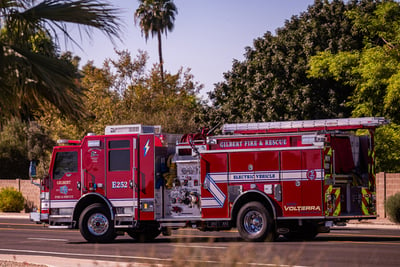
Many questions are swirling regarding how high-voltage power is managed on electric fire trucks and how electrification technology impacts firefighter safety, routine maintenance and overall truck performance.
Pierce Manufacturing sat down with the engineering team to talk through some of the most common questions they've encountered in our Electric Fire Truck Q+A series.
The subject of this second edition in our Q+A series concerns electric fire trucks and high-voltage (HV) power.
Question: Are high voltage areas on electric fire trucks dangerous?
Answer: High voltage systems are designed to be safe under normal operating conditions, but the placement of high-voltage elements can significantly affect firefighter functionality, serviceability and overall safety.
Electric fire trucks use high-voltage systems to power the vehicle, but electric fire truck manufacturers take precautions to keep these areas safe for firefighters. Arguably, the system exposes the service technicians to more hazards. Accidental contact with energized high-voltage parts during maintenance and other service intervals can lead to significant injury.
There are, however, significant differences between manufacturers in their approach to high-voltage area management, design architecture and component packaging.
The Pierce® Volterra™ electric fire truck consolidates and isolates electrical components to a single area on the fire truck body behind the cab. The Pierce Volterra was specifically designed to keep all electrical elements in one place so firefighters could easily manage all daily truck operations and maintenance with confidence they will not inadvertently encounter high-voltage wiring or components.
With the Pierce Volterra, firefighters can access the engine, cab, chassis braking system, pumphouse and all other components found on traditional apparatus, without coming in contact with any high-voltage parts, wiring or accessories, because areas of crossover are simply not there.
As fire department representatives consider adding an electric fire truck to their fleet, it’s important to ask electric fire truck manufacturers about high-voltage component and wiring placement because it has a significant impact on ease of operation and maintenance.
Question: Can firefighters perform routine maintenance on trucks with high-voltage power?
Answer: Yes, but it depends on the truck’s configuration. Firefighters should always follow hazard protocol.
 When it comes to any hazard, firefighters are trained to follow established safety protocols. From protection from bloodborne pathogens to donning an SCBA, firefighters know how to assess hazards and respond accordingly with appropriate personal protective equipment (PPE).
When it comes to any hazard, firefighters are trained to follow established safety protocols. From protection from bloodborne pathogens to donning an SCBA, firefighters know how to assess hazards and respond accordingly with appropriate personal protective equipment (PPE).
Working with high voltage areas on fire trucks is no different.
When high-voltage components and wiring are consolidated in a single cabinet and isolated from all other truck functions, like the Pierce Volterra, firefighters, fleet mechanics or other service providers can perform all regular maintenance and inspection tasks.
Without consolidated and isolated high-voltage components, firefighters and municipal service technicians are unable to perform routine fire truck maintenance. In these cases, firefighters must follow hazard protocols and use appropriate PPE.
If high-voltage electrical components run through the chassis, along the water tank, through the pump house or along the truck body, it is necessary to confirm power is off and it is safe to operate around before any maintenance can be performed. This work should only be conducted by those qualified.
Depending on HV component placement, simple weekly, monthly and bi-annual service items may require technicians and maintenance teams with high-voltage credentials. Not only is this impractical, but it also becomes a financial burden on fire departments to appropriately train and certify staff to perform routine fire truck care.
Consolidated high-voltage cabinets have a significant impact on limiting the total cost of ownership:
- Routine maintenance on traditional components can proceed as normal through your standard service network.
- Conducting routine maintenance with existing service technicians improves overall uptime.
- The added cost to hire specialized high-voltage technicians can be minimized.
There’s another important advantage to the strategic placement and consolidation of high-voltage systems and wiring. Fewer connections mean fewer places for corrosion or other issues. Less wire also means fewer opportunities for wires to rub or be damaged. Moreover, if a problem occurs, firefighters have fewer components to troubleshoot and need only look in a singular area accessible with a raised cab.
Consolidated and isolated high-voltage components allow firefighters to perform routine maintenance and some issues can be eliminated altogether when there is less wiring and fewer connections.
Question: How easily do electric fire trucks fit into existing fleets?
Answer: Easily, but it depends on the HV integration and its impact to the overall truck layout and control.
 Adding any new truck to an existing fire department fleet can present challenges. When apparatus is designed and manufactured to match others in the fleet in regards to configuration, component placement and compartmentation, it makes it easier for firefighters to move seamlessly from one truck to another.
Adding any new truck to an existing fire department fleet can present challenges. When apparatus is designed and manufactured to match others in the fleet in regards to configuration, component placement and compartmentation, it makes it easier for firefighters to move seamlessly from one truck to another.
The Pierce Volterra was designed with ease of operations in mind. When you look at a Pierce Volterra, you’d never know it is an electric fire truck. It is designed to fit into an existing fleet and can be manufactured to match the structure and configuration of your existing Pierce apparatus. Aside from the high-voltage cabinet, everything else on the truck can be manufactured to match the design of your existing fleet of vehicles. This allows fire service members to operate all fleet trucks with consistency.
Question: Are high-voltage electric fire trucks faster and more maneuverable than other fire trucks?
Answer: They can be, but the brakes are all the same size.
 It’s no surprise to hear fire truck manufacturers talk about how new electrification technology makes fire trucks stronger, faster and more versatile. It’s true; but all of these attributes must match real-world applications.
It’s no surprise to hear fire truck manufacturers talk about how new electrification technology makes fire trucks stronger, faster and more versatile. It’s true; but all of these attributes must match real-world applications.
Reaching top speed is just not realistic in emergency response scenarios on narrow rural roads or in congested city traffic. Trucks need speed, certainly, but they are not racehorses, they are workhorses. Fire trucks, electric or not, need to be reliable and arrive on scene safely.
In addition to speed, maneuverability is a highly desirable feature on fire apparatus and the Pierce Volterra offers all-wheel steer to ensure faster speeds can be managed safely. This feature, however, is not limited to just our electric vehicles; TAK-4 T3™ all-wheel steer has been available on all of Pierce’s traditional fire trucks for years.
It comes down to a realistic balance of technology and performance. New technology pushes the boundaries and brings tremendous value to every aspect of firefighting, but fire truck performance and reliability trump new technology every time.
Pierce Volterra: A Distinct Difference
The Pierce Volterra electric fire truck is designed to provide fire departments with a zero-emission vehicle with dependable and consistent power to meet all fire ground capabilities.
With consolidated and isolated high-voltage components, the Pierce Volterra platform of electric vehicles prioritizes firefighter and service technician safety, while promoting ease of operation.
Learn more about electric fire trucks, the Volterra platform of electric vehicles or contact your local dealer today to hear more about why a distinct power source makes all the difference.